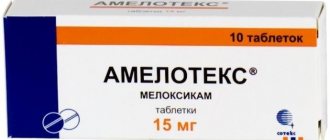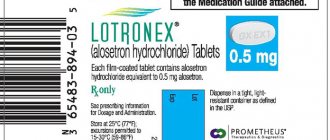Arketal Rompharm, 50 mg/ml, solution for infusion and intramuscular administration, 2 ml, 10 pcs.
Undesirable drug combinations
The combined use of ketoprofen with other NSAIDs (including selective cyclooxygenase-2 inhibitors and salicylates in high doses) is not recommended due to the increased risk of gastrointestinal bleeding and ulceration of the gastrointestinal mucosa.
Simultaneous use with anticoagulants (heparin, warfarin), antiplatelet agents (ticlopidine, clopidogrel) increases the risk of bleeding. If the use of such a combination is unavoidable, the patient's condition should be carefully monitored.
When used simultaneously with lithium preparations, it is possible to increase the concentration of lithium in the blood plasma up to toxic values. The concentration of lithium in the blood plasma should be carefully monitored and the dose of lithium preparations should be promptly adjusted during and after the use of NSAIDs.
Ketoprofen increases the hematological toxicity of methotrexate, especially when used in high doses (more than 15 mg per week). The time interval between stopping or starting therapy with ketoprofen and taking methotrexate should be at least 12 hours.
Combinations to use with caution
During therapy with ketoprofen, patients taking diuretics, especially if dehydration develops, have a higher risk of developing renal failure due to a decrease in renal blood flow caused by inhibition of prostaglandin synthesis. Before starting to use ketoprofen in such patients, rehydration measures should be carried out. After starting treatment, it is necessary to monitor kidney function.
The combined use of ketoprofen with angiotensin-converting enzyme (ACE) inhibitors and angiotensin II receptor antagonists (ARA II) in patients with impaired renal function (with dehydration, in elderly patients) can lead to worsening renal dysfunction, including the development of acute renal disease insufficiency.
During the first weeks of simultaneous use of ketoprofen and methotrexate at a dose not exceeding 15 mg per week, blood tests should be monitored weekly. In elderly patients or if there are any signs of renal impairment, the study should be performed more frequently.
Combinations to take into account
Ketoprofen may weaken the antihypertensive effect of antihypertensive drugs (beta-blockers, ACE inhibitors, diuretics).
Concomitant use of ketoprofen with selective serotonin reuptake inhibitors (SSRIs) increases the risk of gastrointestinal bleeding.
Concomitant use with thrombolytics increases the risk of bleeding.
The simultaneous use of ketoprofen with potassium salts, potassium-sparing diuretics, ACE inhibitors, ARB II, NSAIDs, low molecular weight heparins, cyclosporine, tacrolimus and trimethoprim increases the risk of developing hyperkalemia.
When used simultaneously with cyclosporine and tacrolimus, there may be a risk of additive nephrotoxicity, especially in elderly patients.
The simultaneous use of several antiplatelet drugs (tirofiban, eptifibatide, abciximab, iloprost) increases the risk of bleeding.
Ketoprofen increases the plasma concentration of cardiac glycosides, blockers of “slow” calcium channels, cyclosporine, methotrexate and digoxin.
The combined use of ketoprofen with other NSAIDs (including selective COX-2 inhibitors), salicylates, glucocorticosteroids, and ethanol increases the risk of developing adverse events from the gastrointestinal tract.
Ketoprofen may enhance the effect of oral hypoglycemic and some anticonvulsants (phenytoin).
Concomitant use with probenecid significantly reduces the plasma clearance of ketoprofen.
Nonsteroidal anti-inflammatory drugs may reduce the effectiveness of mifepristone. NSAIDs should be started no earlier than 8–12 days after mifepristone is discontinued.
Ketoprofen is pharmaceutically incompatible with tramadol solution due to precipitation.
Pharmacokinetics
Suction
Absorption is fast. Tmax in plasma - 15-30 min. Bioavailability - more than 90%.
Distribution
Plasma protein binding - 99%. Therapeutic concentration in synovial fluid lasts 6-8 hours.
It does not penetrate the BBB in significant quantities.
Metabolism
Almost completely metabolized in the liver by glucuronidation. Subject to a first-pass effect through the liver.
Removal
Excreted by the kidneys - 60-80% in the form of glucuronide in 24 hours.
Similar drugs:
- Panoxen Oral tablets
- Picamilon (Picamilonum) Oral tablets
- Cavinton forte Oral tablets
- Lopirel Oral tablets
- Nemulex Gel for oral suspension
- Valusal Gel for external use
- Cardiomagnyl Oral tablets
- Rheopolyglukin Solution for infusion
- VAP 20 (Vap 20) Concentrate for the preparation of solution for infusion
- Pentilin Solution for infusion
** The Drug Directory is intended for informational purposes only. For more complete information, please refer to the manufacturer's instructions. Do not self-medicate; Before starting to use the drug Arketal Rompharm, you should consult a doctor. EUROLAB is not responsible for the consequences caused by the use of information posted on the portal. Any information on the site does not replace medical advice and cannot serve as a guarantee of the positive effect of the drug.
Are you interested in the drug Arketal Rompharm? Do you want to know more detailed information or do you need a doctor's examination? Or do you need an inspection? You can make an appointment with a doctor - the Euro lab is always at your service! The best doctors will examine you, advise you, provide the necessary assistance and make a diagnosis. You can also call a doctor at home . Euro lab clinic is open for you around the clock.
** Attention! The information presented in this medication guide is intended for medical professionals and should not be used as a basis for self-medication. The description of the drug Arketal Rompharm is provided for informational purposes only and is not intended for prescribing treatment without the participation of a doctor. Patients need to consult a specialist!
If you are interested in any other drugs and medications, their descriptions and instructions for use, information about the composition and form of release, indications for use and side effects, methods of use, prices and reviews of drugs, or you have any other questions and suggestions - write to us, we will definitely try to help you.
Side effect
From the digestive system:
NSAID gastropathy, abdominal pain, dyspepsia (nausea, vomiting, heartburn, flatulence, loss of appetite, diarrhea), stomatitis, liver dysfunction, change in taste.
From the nervous system:
headache, dizziness, insomnia, agitation, nervousness, drowsiness, depression, asthenia, confusion or loss of consciousness, migraine, peripheral neuropathy.
From the senses:
noise or ringing in the ears, blurred vision, conjunctivitis, dry mucous membrane of the eye, eye pain, conjunctival hyperemia, hearing loss, vertigo.
From the cardiovascular system:
increased blood pressure, tachycardia.
From the hematopoietic organs:
agranulocytosis, anemia, hemolytic anemia, thrombocytopenia, leukopenia.
From the urinary system:
edema syndrome, cystitis, urethritis, renal dysfunction, interstitial nephritis, nephrotic syndrome, hematuria.
Allergic reactions:
skin rash (including erythematous), urticaria, skin itching, rhinitis, angioedema, bronchospasm, exfoliative dermatitis, anaphylactic shock.
Local reactions:
burning or pain at the injection site.
Other:
increased sweating, hemoptysis, nosebleeds, myalgia, muscle twitching, shortness of breath, thirst, photosensitivity, with prolonged use in large doses - vaginal bleeding.
Overdose
Overdose was detected at doses of more than 2.5 g of ketoprofen.
Symptoms:
increased dose-dependent side effects: cramps, feeling of heaviness in the legs, increased blood pressure, ringing in the ears, blurred vision, rash, nausea, vomiting, epigastric pain, diarrhea, gastrointestinal bleeding, headache, dizziness, incoherence (incoherence), confusion, drowsiness, convulsions, coma, respiratory depression.
Treatment:
carry out symptomatic therapy. A specific antidote is unknown. Provide appropriate hydration, monitor renal clearance, and correct acidosis. If necessary, hemofiltration is used.
Rules for administering the drug
The IM drug is administered deeply, slowly, into the upper outer quadrant of the buttock, under strictly aseptic conditions. Subsequent injections are administered alternately into both buttocks.
IV: 1) short-term infusion - from 100 to 200 mg of ketoprofen is diluted in 100 ml of 0.9% sodium chloride solution and administered over 0.5-1 hour; administration can be repeated every 8 hours for no more than 48 hours; 2) long-term infusion - from 100 to 200 mg of ketoprofen is diluted in 500 ml of infusion solution (0.9% sodium chloride solution, lactated Ringer's solution, dextrose solution) and administered over 8 hours; administration can be repeated every 8 hours for no more than 24 hours.
Due to the fact that ketoprofen is sensitive to light, the bottle or infusion bag should be covered with black paper or aluminum foil.
Contraindications for use
- complete or incomplete combination of bronchial asthma, recurrent polyposis of the nose and paranasal sinuses and intolerance to acetylsalicylic acid or other NSAIDs (including a history);
- peptic ulcer of the stomach and duodenum in the acute phase;
- ulcerative colitis in the acute phase;
- Crohn's disease;
- diverticulitis;
- peptic ulcer;
- hemophilia and other blood clotting disorders;
- active gastrointestinal bleeding;
- severe renal failure (creatinine clearance less than 30 ml/min);
- progressive kidney disease;
- severe liver failure or active liver disease;
- condition after coronary artery bypass surgery;
- confirmed hyperkalemia;
- inflammatory bowel diseases;
- children under 15 years of age;
- hypersensitivity to the components of the drug;
- hypersensitivity to other NSAIDs.
Carefully :
anemia, bronchial asthma, alcoholism, tobacco smoking, alcoholic cirrhosis of the liver, hyperbilirubinemia, liver failure, dehydration, sepsis, chronic heart failure, edema, arterial hypertension, blood diseases (including leukopenia), stomatitis, ischemic heart disease, cerebrovascular diseases, dyslipidemia /hyperlipidemia, diabetes mellitus, peripheral arterial disease, chronic renal failure (creatinine clearance 30-60 ml/min), a history of ulcerative lesions of the gastrointestinal tract, the presence of Helicobacter pylori infection, long-term use of NSAIDs, severe somatic diseases, simultaneous use of oral corticosteroids (including including prednisolone), anticoagulants (including warfarin), antiplatelet agents (including clopidogrel), selective serotonin reuptake inhibitors (including citalopram, fluoxetine, paroxetine, sertraline), old age.
Dosage regimen
The drug is administered to adults
IV drip or IM. IM - 100 mg 1-2 times a day, IV drip - 100-200 mg in 100-500 ml of 0.9% sodium chloride solution. Infusions are carried out only in a hospital, no more than 300 mg over 0.5-1 hour.
The maximum daily dose is 300 mg.
Treatment with the drug is carried out for a short time (2-3 days). If necessary, treatment is continued with other dosage forms.
In elderly patients
The drug is recommended to be used in the minimum effective dose. Patients require regular monitoring because... Gastrointestinal bleeding is possible during NSAID therapy.
In patients with renal failure
The drug is recommended to be used in the minimum effective dose, which is then adjusted depending on the state of renal function.
Indications of the drug
Inflammatory and degenerative diseases of the musculoskeletal system:
- rheumatoid arthritis;
- psoriatic arthritis;
- Bechterew's disease (ankylosing spondylitis);
- gouty arthritis;
- osteoarthritis.
Intended for symptomatic therapy, reducing pain and inflammation at the time of use, does not affect the progression of the disease.
Pain syndrome:
- myalgia;
- ossalgia;
- neuralgia;
- tendonitis, bursitis;
- arthralgia;
- radiculitis;
- adnexitis;
- otitis;
- headache;
- toothache;
- pain due to cancer;
- post-traumatic and postoperative pain syndrome accompanied by inflammation.
Algodysmenorrhea, childbirth (as an analgesic and tocolytic agent).
special instructions
During treatment, monitoring of the peripheral blood picture and the functional state of the liver and kidneys is necessary.
If it is necessary to determine 17-ketosteroids, the drug should be discontinued 48 hours before the study.
The use of ketoprofen can mask the signs of an infectious disease.
If renal or liver function is impaired, dose reduction and careful monitoring are necessary.
To reduce the risk of developing adverse events from the gastrointestinal tract, the minimum effective dose should be used over a minimum short course.
Impact on the ability to drive vehicles and operate machinery
During the treatment period, care must be taken when driving vehicles and engaging in other potentially hazardous activities that require increased concentration and speed of psychomotor reactions.


